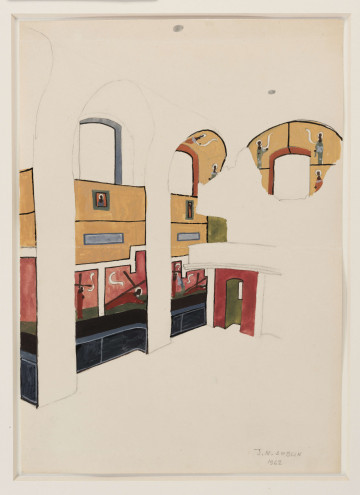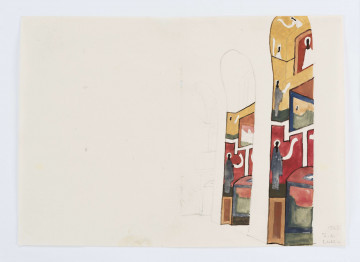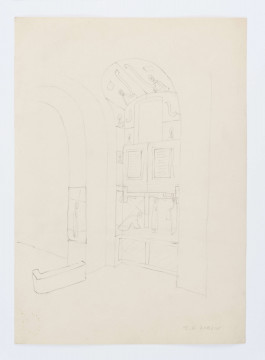
Unimplemented design for the polychrome for the Academic Church of the Catholic University of Lublin. View of the south-western side of the nave
1962
National Museum in Lublin
Part of the collection: Religious scenes
Polychromies in Orthodox, Greek and Roman Catholic temples are an important part of Jerzy Nowosielski's work, being an expression of coexistence and interpenetration of Eastern and Western culture, icon painting and abstract art. In the early 1960s, the artist received a proposal to create a polychrome in the academic church of the Catholic University of Lublin. As in the case of other monumental painting projects, Nowosielski treated it as a kind of an ecumenical sermon, the aim of which was to show the unity of worship. According to the artist's letter to Andrzej Grzegorczyk, for Lublin he created "a completely uncompromising project" with a clear iconographic message, the realization of which he was particularly keen on. Unfortunately, Nowosielski's vision was rejected, and the artist's idea is illustrated only by a set of preserved design sketches, nine of which were bought by the National Museum in Lublin thanks to a grant from the Ministry of Culture and National Heritage. In these sketches Nowosielski worked out not only the overall concept of the painting decoration, but also the furnishing of the temple, including the form of the main altar. The design of the polychrome, consistent with the traditional programme of Byzantine churches, assumed a zonal composition of framed scenes closely filling the interior. As in the case of the paintings of other churches, Nowosielski prepared several versions of the polychromy for the Holy Cross Church, differing in both the iconographic programme and colours.
The design sketch for the chancel wall decoration includes panoramic framed scenes of Crucifixion, Last Supper, Deesis and Transfiguration on Mount Tabor. The central composition is the scene of Deesis, a prayer petition addressed to God through the intermediary of the Virgin Mary and John the Baptist. Situated on the axis of the presbytery, Christ is portrayed as Pantocrator (All-Powerful) in the type of Salvator Mundi (Saviour of the World) with a royal apple or globe in his hand. On his left he is accompanied by the Virgin Mary. In his Lublin project, Nowosielski departed from the traditional compositional scheme, replacing the figure of St John with an elaborate representation of the Baptism of Christ in the Jordan.
Anna Hałata
Author / creator
Dimensions
cały obiekt: height: 34,3 cm, width: 17,9 cm
Object type
painting
Technique
painting technique
Material
cardboard, aquarel
Creation time / dating
Creation / finding place
Owner
The National Museum in Lublin
Identification number
Location / status

1962
National Museum in Lublin

1962
National Museum in Lublin

1962
National Museum in Lublin
DISCOVER this TOPIC
Castle Museum in Łańcut
DISCOVER this PATH
Educational path